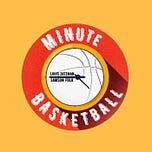
Reports of the death of the NBA big man have been greatly exaggerated.
Look, for example, at the current NBA playoffs. Four teams remain, and four centers will see the bulk of the important minutes. But each of those players is vastly different from the next. That’s rare in basketball context; many NBA champions have followed a similar blueprint. But as Detroit Pistons Head Coach Dwane Casey is fond of saying, there’s more than one way to skin a cat.
Change ‘cat’ to ‘NBA big men’ and ‘skin’ to ‘build an NBA team around’ and he’s got it exactly right.
In the East, Daniel Theis is the glue guy, the consummate pro, who does whatever is asked of him, as long as it’s not too difficult to do. Bam Adebayo does that, too, plus the hard stuff. He’s the All-Around Big, the Herculean Hero, the Atlas Rugged.
In the West, Nikola Jokic, a man who helps redefine what we think athleticism looks like on a basketball court. Bulging biceps and vertical leap are as present in Jokic’s game as Jacob Wohl is in hipster coffee shops. Balance, mindfulness, creativity, and a remarkable touch drive Jokic’s game. With the Lakers, Anthony Davis was always supposed to be here. A first overall pick who has flirted with MVP votes for a large portion of his career and has the biceps, length, vertical leap, and touch all put together. Both Davis and Jokic have active defenses around them and a couple of star shotmakers (Jamal Murray, LeBron James) but hell, this is a big man renaissance. So, let’s focus on them.
The NBA has whittled its remaining competitors to four. And those four teams have approached the big position from seemingly kitty-cornered angles. The ideas that NBA big men are extinct, unimportant, or homogenous are ridiculous. Let’s dive into what the four remaining bigs offer, how they differ, and what to expect from the Semi-Final matchups, approaching the two battles from the trenches.
Looking West - Folk
A Litmus Test
Montrezl Harrell, recently minted as the NBA’s 6th man of the year and a player who is correctly celebrated for an improved defensive presence, some serious punch as a roll man, and a lot of value provided to the Clippers this regular season. Unfortunately for Harrell, he underwent Jokic’s litmus test. Jokic’s litmus test doesn’t test for acidity though, it determines how viable an option you are against traditional big men attributes. There are other big men who can bang around in the post, of course, but Jokic’s exceptional passing talent dictates that you guard him 1-on-1 or you die as you double him, just as the Clippers did.

Jokic can operate in the high-post or low-post. He can read the double from the top or bottom and pass accordingly. And hell, just for fun, he can space from 3-point land and make insane foot shuffling, bastardized Dirk fadeaways. That’s why he’s led the entire NBA playoffs in touches per game. He is the definitive offensive hub of a Western Conference Finalist who just beat the team that was considered the favourites by bettors and analysts. Listen motherfucker, nothing is going to stop you from getting this work in the post. So, put your knee under his butt, take away some of the weight, make him do everything up top instead of backing you under the basket, and hope to god your teammates don’t get back cut. For these reasons, it’s not particularly surprising that the Clippers were much better with Zubac on the floor (+33) than Harrell (-36). I understand the Clippers value Harrell, but they signed their death note when they decided they wanted his offense instead of Zubac’s defense. Frantically doubling Jokic, and allowing him to eviscerate your defense with the pass - not the best look. Harrell took the litmus test and ended up much closer to “micro-ball” than the Clippers wanted.
That’s what makes Jokic so special. His ability to punish teams with old school, beat em’ up post-up basketball. Only, it’s packaged together with a 3-point shot, the NBA’s best floater, and a passing pedigree that very few players at his size have ever possessed. We see passing angles that players don’t with our birds eye view from the broadcast, but Jokic is closer to us than most and he can throw passes on a frozen rope. He’s a superstar, and if his old school yet futuristic game becomes a model for NBA bigs in the future, we’ll all be the luckier for such an unlikely outcome. Jokic will catch the ball on the short-roll and sell 2 different passes to the defense before he receives the ball, 2 more once he catches it, and the death stroke will come in the form of a gobsmacking floater. Every pass he fakes is a pass he can make, and teams are left vibrating in place. How else would one of the NBA’s slowest players so casually march to the rim?
You can consider me one of the people who was duped by Game 1 of the Lakers-Rockets series. However (comma) the Rockets did succeed in one very specific way: they played Dwight Howard and Javale McGee off the floor almost completely, after both of those players were a massive part of the Lakers regular season defensive identity.
Play Big
The bad news? Anthony Davis absolutely killed it on the defensive end. He’s been resistant to minutes at the ‘5’ his whole career despite many asking it of him. Many have wondered if he dislikes the physical toll that position takes on him. Luckily, that wasn’t the case with the Houston Rockets, who played maybe the smallest type of basketball in the NBA’s history. Davis dominated inside the arc against Houston’s rendition of micro-ball. Was Russell Westbrook disappointing as a 4-on-3 decision maker? Yes. Did Davis dominate in rotation, stunt towards players with genius reads, and cover immense ground defensively? Yes. I’ve spent too much of my life wondering if Westbrook will do certain things and too little appreciating Davis’ defense.
Offensively, Davis should be prepared for the many swipes and digs that Gary Harris, Torrey Craig and Jerami Grant will throw at him. After all, he just played the always swipe-y Rockets, a definitive crash course in that type of defense. 4 turnovers a game was ugly to see, but at least he’s seen it before. Ideally, the wheels are turning and the adjustments will come. The impetus for change is rarely welcome when it makes its presence known, and fans of Davis’ have long lamented his shot selection. In the second round he ranked in the 100th percentile at the rim and the short mid-range. 70-percent is a great percentage at the rim, and Davis shot 72-percent from the paint as a whole. Hopefully that success brings him a little bit closer to the rim, but nobody else in the playoffs took a higher percentage of their shots from the long mid-range (or mid-range as a whole) than Davis did. It’s a read and react game, of course, but Davis settling for long jumpers against Jokic is a recipe for disaster.
Davis is a do-everything superstar on both ends of the court. His size and skill are infinite, and if typical NBA bigs look like him in the future, the league will be almost impossible to imagine. “Unicorn” as a term has become somewhat commonplace, but Davis’ is more deserving than most who wear that moniker.
Quite frankly, I can’t wait to see how these two match up in the present day. Or, if the Lakers will even allow for that, because they can always bring Howard and McGee back into the fold. How does Jokic’s lack of verticality on defense fare when he’s facing off against the greatest lob threat of all time in Davis? Is there a possibility that this series goes jumbo? Are we in for Plumlee vs. Davis and Jokic vs. Howard or McGee? It’s certainly possible, and would probably be fun.
Either way, this series has a good chance at being the first time the Western Conference Finalist has been determined by centers since Pau Gasol and Tim Duncan battled in 2008.
Looking East - Zatzman
The Glue Guy
For a man who doubles as a battleground, Daniel Theis really isn’t all that interesting. He’s solid, yes, and other than being apparently a magnet for the bad whistle -- which resulted in him fouling out of game one against the Miami Heat -- Theis isn’t notable for too much else.
Except for the fact that he helps the team so damn much. In the smallest ways possible.
Theis averaged more or less 9.5 points, 6.5 rebounds, 1.5 assists, and 1.5 blocks per game in the regular season, and those numbers have carried over to the playoffs. He can finish well when others create for him. He’s not a shooter, per say, but he’ll step back and hit the triple when unguarded. He’s not a traditional rim protector, standing only six-foot-eight, but he’s long and strong and tracks shots with the best of them, especially from behind. He’s switchable enough to deter opposing guards or wings, particularly in late clock situations.

He’s not a visionary passer, but he hits the open man and rattles through quick decisions.

The quick-decision thing, by the way, could be the most important part. You don’t have to make the value-added choice with every opportunity as long as you make the value-sustained choice immediately. Few of his plays are highlights, but he doesn’t diminish advantages, and he’ll carry them side-to-side, offering his more talented teammates space in which to thrive.

Perhaps Theis’s best skill is his screen-setting. Not exciting, sure, but pretty pretty useful. And he’s by no means just average when it comes to screens. He was one of only 11 players to average 10.0 screen assist points per game or more in the regular season. He makes great contact, and he has a nose for angles. With Kemba Walker as Boston’s most frequent pick-and-roll handler, even a spare inch is enough for the speedy Walker to wreak havoc. And Theis creates more than an inch with his screens.
He’s not just physical, but he’s also a creative screener. Theis has repopularized the ‘Gortat screen,’ wherein he slips the original screen and seals his own man in the lane, allowing the guard to waltz to the rim with no second line of defense to speak of.
Theis’s sealing is supposed to significantly boost Boston’s ceiling. (Samson made me include that joke.) But in game one, Boston’s guards weren’t ready to use the space Theis created for them.

That’s not Theis’ fault, though. What he offered in game one was enough!
Theis doesn’t hurt the Celtics anywhere, and he helps in the cracks. That’s a viable future for the big man. For Boston, it’s enough to let the isolation wizards in Jayson Tatum, Kemba Walker, and eventually Gordon Hayward thrive; in game one, Theis finished a team-high plus-12 in the three-point loss. Pretty effective for a glue guy.
You know who else finished a plus-12, accomplishing that identical number in a very different way? Bam Adebayo.
Atlas Rugged
Consider the Rapture. It’s a religious event wherein all the goodness in the world ascends. It’s the explicit making of a thing into its Platonic ideal; the angelic on Earth become literal angels. The spirit transcends the earthly form. Also inherent to the Rapture, though, is violence. The act of choosing, even self-inflicted choice, and the violence of the wicked left behind. Rapture as portrayed in film is much more often about those left behind than those chosen. It’s why there’s so often flames, flood, famine occuring off-screen; Armageddon follows Rapture, at least for those unworthy souls. They transform into their symbolic collective purpose of evil.
That’s basically what happened when Bam Adebayo rose to block Jayson Tatum at the rim and saved the game for the Heat.

The rim seemed unprotected, Tatum the worthy chosen to tie the game. But Adebayo rose, late, transcended gravity, and met Tatum inches above the cylinder. He ascended. But violence wasn’t far behind. Adebayo’s hand then wrist then entire arm bent at a sickly angle. For a moment it seemed like something might snap. Adebayo was, after all, trapped between the forward force of Tatum and the cold steel of the rim. A weaker man, any man lesser than a Greek God, really, would have suffered serious injury.

When you combine the speed required to close the gap so late, the length necessary to reach the ball, and the strength to keep the ball from entering the rim, let alone not snapping the defender’s wrist, the block was a play that only one player in the NBA could make. The Miami Heat are joyous to employ him as their starting center.
In building a team around the center spot, Boston went one way, and Miami went another way completely.
I’m on record as being a big fan of Bam Adebayo’s aesthetic and poetic purpose in the NBA, but he’s not such a bad basketball player, either. Correction: He is the future of the center spot in the NBA. One possible vision of it, that is. He averaged roughly 16 points, 10 rebounds, 5 assists, 1 blocks, and 1 steal per game in the regular season, and that stayed true in the playoffs. But that’s just the start of Adebayo’s value.
Adebayo contains Theis within him, and a whole lot more, besides. Adebayo is a better passer, finisher, shooter, rim protector, perimeter defender.

Think Theis is a good screener? Adebayo was third in the league in screen assist points per game, averaging 12.1. He creates acres of space with every mammoth hip swivel. However, in game one, Adebayo finished with zero screen assists; you may think that’s a failure of execution, but in fact, the Heat shifted Adebayo into a creator out of the high post, and he responded with a game-high nine assists.
The Heat gave Adebayo the ball and ran around him like kids in the playground, letting Adebayo sniff where the advantage was greatest. His ability to hit the home run with value-added plays gives Miami one of its biggest advantages in the series.

That changeability, ability to pivot from screen-setter to play-initiator, is what makes Adebayo so deadly.
Defensively, he can swallow almost any player in the league, guard, wing, or big. According to nba dot com’s data, he was a 90th percentile or better defender in static events like isolation or post-ups. Guards can’t get around him and can’t shoot over him. He’s a meaty rebounder, leading the league in defensive box outs in the regular season, snatching anything in his realm of orbit.
In game one, his hulking presence in the middle of Miami’s 2-3 zone didn’t actively defend the rim as much as passively deter opponents from ranging near. The Celtics attempted only 19 shots at the rim in the game. Adebayo, by the way, still defended the rim pretty well, contesting a game-high 18 shots. He wreaked havoc.

On that play, Adebayo did this, in order: switched, blitzed a screen, recovered to interrupt a pass, walled off a drive, rotated, walled off another drive, and tipped a pass for the steal. That shouldn’t be possible for a player who also doubles as one of the strongest, move immovable centers in the league. Adebayo is the future of the big position in that he combines every skill, with ferocious intent, into one deific frame.
While Boston went for comfort with Theis, Miami went for control with Adebayo. Boston makes up for Theis’ limits with a cadre of star wings. For Miami to win, Adebayo has to fully and completely dominate Theis, up and down. He did that in game one. But Theis was no slouch; if he didn’t foul out, it’s possible the game ended differently.
Goes to show, there are still vastly different ways to build a winning team in the modern NBA.
















Share this post